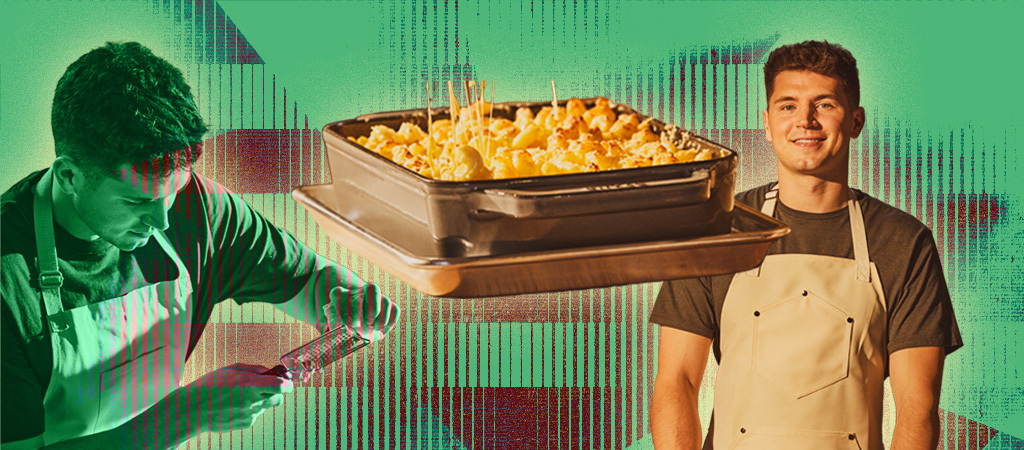
Nick DiGiovanni is one of those culinary content creators you hear about, perhaps dismiss, and then keeping hearing about more and more and more and… Because the dude is big. DiGiovanni took a stint as a contestant on Gordon Ramsay’s MasterChef and leveraged that moment to create an entire digital empire, which, in 2025 extends way past URLs. His journey from amateur chef and the first Harvard undergraduate with a self-constructed food degree to tween heartthrob with his own salt available in Walmart stores throughout the US, author of a best-selling cookbook and over 20M subscribers on Youtube reveals heaping helpings of brains, passion, determination and ingenuity.
DiGiovanni’s latest claim to fame outside of MasterChef and being a protege of Sir Ramsay, is the construction of humongous versions of American food staples like chicken nuggets, sushi rolls, fortune cookies, and cake pops, which have continued to produce viral moments and break Guinness World Records. We caught up with the chef on the eve of the launch of his latest big venture, Nick’s Kitchen, a new Youtube channel dedicated to teaching home cooks of every age simple recipes and techniques with Food Network quality production, and went in-depth on how to make his signature mac-n-cheese, including why he uses five different cheeses to get the best flavor, texture, and melt.
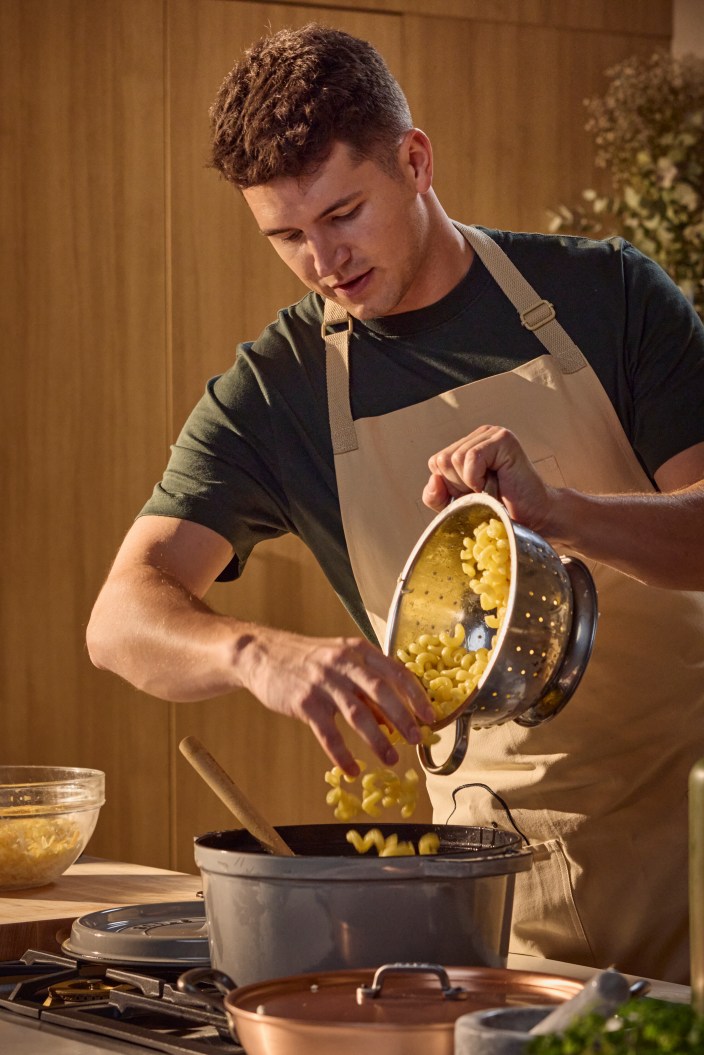
What can we expect from your new YouTube channel and how will it deviate from content that you’re already putting out?
This one will be called “Nick’s Kitchen,” and the idea was that there hasn’t been a really high quality set of simple recipe videos done in a long time. Back in the day we had a lot of Food Network people watching on TV and Food Network reigned for a really long time, it was the go-to spot for recipes and things.
What I’ve realized on YouTube is that people go and they start out with channels that are supposed to be all about food, kind of like myself. It evolved over time into this idea of food entertainment where it’s kind of a little bit clickbaity and gimmicky – there’s totally a place for it because people shift to it a lot of the time, the reason people shift to it is because it just gets more viewership and it’s more widely appealing.
I feel like there’s a gap and there’s a place for really high-quality recipe videos. Simple, no gimmicks, nothing over the top, videos that are all about 10 minutes and straightforward. We put together a really great team. We spent a ton of time doing the recipe testing and putting together the set – it’s beautifully shot. The sound is all there, so many different angles are there. We’re being serious about the color work afterward – it really blew my mind. It’s really exciting – we can come to YouTube with this modern food network, is my thought.
Jumping into the recipe — what makes your Mac and Cheese so special?
When I think of any type of food, the first word I think about is balance. I apply that to every single recipe, and I think that’s what makes so many of the special foods that you eat in your life as special as they are. Take the mac and cheese cheese for an example, I think the first thing you need to think about is that there’s two parts. There’s macaroni and there’s cheese.
For the macaroni, I veered away from traditional elbow Mac and use Cavatappi, which is a little bit longer, but more importantly has those nice ridges that hold the sauce a little bit better. That’s a first small little change that I make where it does make all the difference – it makes each bite a little bit more fulfilling because they’re a little bit of a bigger piece. Those ridges are really important to hold all that cheesy sauce.
The other side, more importantly, is the cheese. I use five different types in my recipe and it sounds like a lot, but often mac and cheese has a lot of different types of cheese in it.
There’s no right or wrong answer for the five different types or however many different types that you use. That one (i.e. the cheeses) I leave up to people, I’m like, “What do you like?” I have cheddar in there because I love cheddar cheese. I have mozzarella in there, I have a little bit of goat cheese in there and I have a reason for each cheese.
I think it’s all about balance and it helps so much to think about every step of the process in the recipe. It ends up giving you this perfectly balanced, creamy mac and cheese that hits on everything and boiling it on the top at the end with a little bit of Parmesan, gives that extra saltiness and even some crunch. With regard to texture, flavor, general gooeyness and creaminess, that balance between that actual thick cream itself and the cheese pull that you get, it has everything. That’s what excites me about it.
Is there a specific brand of pasta that you prefer for cavatappi?
I don’t care so much about the brand. Once you put all that cheese and all that sauce on it too, if it’s a good quality pasta from the start, it’s hard to tell once you have all that cheese and all that seasoning on it.
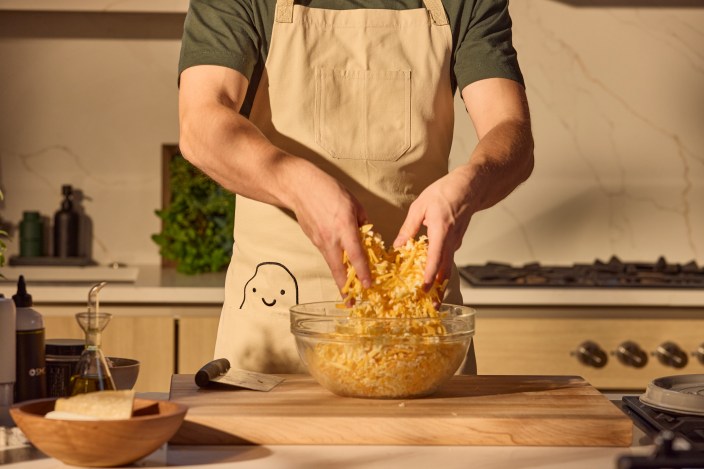
In your recipe, you use both milk and cream, some mac and cheese recipes only use one or the other, so why both?
Cream is fattier, heavier, more decadent, and having the balance between milk and cream, gives you that perfect blend between that leanness that you have in a regular whole milk compared to a heavy cream, and then also that really thick creaminess. You can get away with using just milk, because you can thicken it up as much as you want if you’re using flour. I didn’t want to add any fillers. There’s no roux, there’s no flour base that helps to thicken it all up. Instead, I’m using cheese and not too much liquid and the dish works out really well that way.
My thought was if I can create this mac and cheese without having to add fillers and thickeners really like a flour, like a roux, then I would try without it because sometimes a roux can lead to Mac N Cheese being a little bit mealy, if you don’t pull it off perfectly.
Your recipes calls for dry mustard. Why do you use dry mustard versus other types of mustard?
With dry mustard, I’m trying to control the amount of liquid in the recipe, it’s a little bit easier to make sure that everything comes out the way I want it. If you only have regular mustard and you need to use that, the recipe’s going to be fine. It’s easy to control the amount of mustard you’re putting in when you have that powdered dry mustard because that way you can really see that you’re only adding this tiny little pinch, it packs a punch, and because I’m using so little, it’s nice to put a little sprinkle of that powder.
I don’t think there’s anything wrong with using regular mustard, but I will say if you want to be really specific, you could argue that sort of using unsalted butter instead of a salted butter in a recipe, it’s kind of helping you to control something, it’s helping you to control the moisture content.
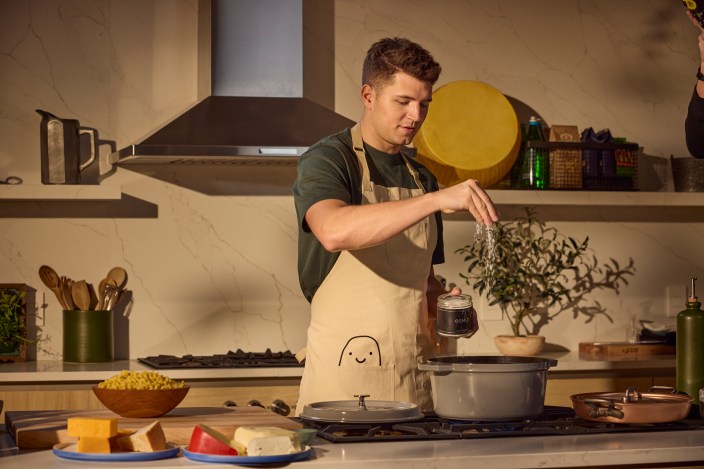
Is that the same rationale behind why you prefer smoked paprika to other types of paprika in this recipe?
Smoked paprika is a personal preference. Some people don’t put any paprika in their mac and cheese, and some people do. I first tried making it with paprika and without, the first thing that comes to my mind is that I use smoked paprika over regular because I think it’s delicious. Typically I use smoked paprika as opposed to regular paprika in any recipe that calls for paprika, if it works.
Getting into the cheeses, you laid out the rationale for each one in the recipe that you shared. Are there any out of the five that are essential for any mac and cheese recipe?
I’ll tell you why I have each one. The cheddar is for sharpness and it gives you that classic mac and cheese flavor. The gouda is for creaminess and has a mild nutty taste. The goat cheese is tangy and creamy, but doesn’t break apart and have that same texture as the other cheeses, it adds a different note on texture. Mozzarella I think is important in a mac and cheese to give you the stretchiness and the gooeyness you’d want. Lastly the Parmesan gives a salty, umami richness for the topping. They all work together, but you can adjust the cheeses however you want – it’s all about personal preference.
I see that you listed olive oil on the recipe but not as one of the ingredients. Is there a specific purpose in the recipe for the olive oil?
That’s to pour over the pasta once you cook it just so it doesn’t stay together. It’s as simple as a quick little drizzle to make sure nothing’s sticking.
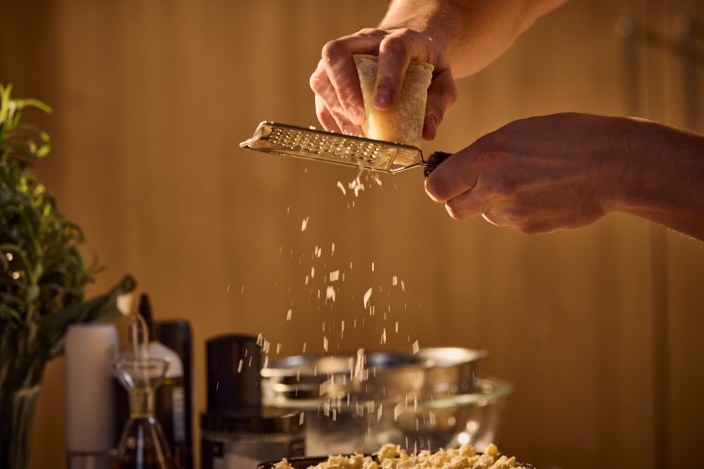
What tools would you say are necessary for a home cook that’s looking to make this recipe? If you were to list these are the things that you need and ready to outside of the ingredients to make this.
A grater for sure, a simple good box grater of some kind. I love a microplane for putting that Parmesan cheese over the top. A grater is really nice, but not an absolute must – it gives such a fine kind of fluffy dust thing of cheese and it’s hard to replicate that with any other tool or in any other way. The nice thing about Mac N Cheese is that it’s pretty easy, so you don’t really need all many different pieces of equipment to make it. A heavy bottom pot is nice to cook it all in.
What are some challenges in making the dish that maybe people who haven’t made mac and cheese before should be aware of?
Sometimes the challenging thing and the toughest part is making that base, that creamy sauce, without getting it either clumpy or breaking it. You can put it on high heat and it starts to get oily and separate. If you can focus on being gentle and thoughtful with the base sauce, then it’s hard to kind of mess up the actual pasta.
If you can focus on making that really gentle base sauce, then the pasta itself is pretty hard to mess up as long as you can go and cook that al dente, since it’ll cook a little bit more once you do that final bake. The key really for a beginner especially, is the focus on that being really gentle and being really careful and watchful of the base of creamy sauce as well.
What are some other ingredients that you don’t use in your recipe that you may recommend to people to add some crunch or spice it up or add dynamic?
The first one that comes to mind is breadcrumbs, I know a lot of people really like having that, but I’ve never been a fan because it distracts from what you really want to be focusing on in mac and cheese. It can be fun if you do it right and not heavy-handed. The only other things some people add bacon or something like lobster if you want to get really decadent and fancy. I like keeping it simple.
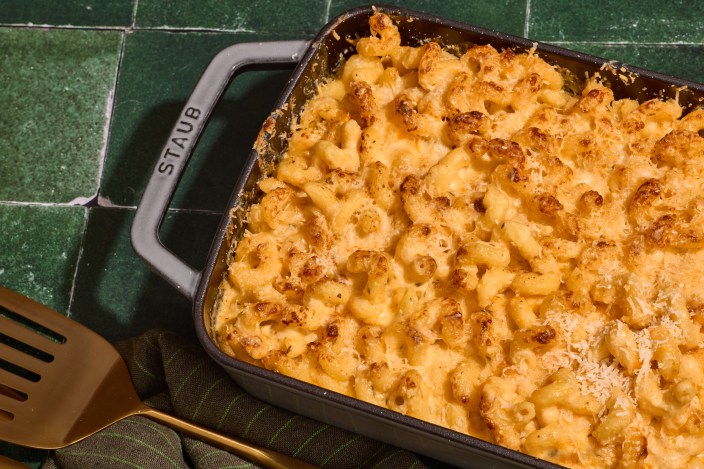
How To Make The Ultimate Mac and Cheese According To Nick DiGiovanni
Ingredients:
- 1 pound cavatappi
- 3 cups cream
- 2 cup milk
- 1⁄2 teaspoon black pepper
- 1 teaspoon dry mustard
- 1⁄4 teaspoon smoked paprika
- 1 large bunch thyme
- 5 crushed garlic cloves
- 1⁄2 pound sharp white cheddar, shredded
- 1⁄2 pound whole milk mozzarella, shredded
- 1 pound gouda, shredded
- 1 (4 ounce) log goat cheese
- 1⁄2 cup grated Parmesan
- Kosher salt and black pepper
Method:
- Pre heat the oven to broil and place a rack 4 inches below the heating element.
- Bring a large pot of water to a boil and season with salt. Add the pasta and cook 2 minutes less than the package directions calls for al dente. Drain the pasta and drizzle with olive oil. Toss the pasta to coat it in the oil, then set aside.
- In the same pot over medium heat, add the heavy cream, milk, black pepper, mustard, thyme, paprika, and garlic cloves. Stir to combine and bring to a very gentle simmer. Simmer for 20-25 minutes, or until the flavors have married and the dairy is slightly reduced. Set a fine mesh strainer over a large mixing bowl. Pour the infused cream through the strainer and discard any solids. Bring the cream back up to a simmer.
- While the cream is coming to a simmer, add the cheddar, mozzarella, and gouda to a medium mixing bowl. Toss well to combine the cheeses. Add half of the cheese, as well as the goat cheese, to the cream mixture and stir gently to melt the cheese. Once the cheese is melted, add the macaroni and stir to incorporate. Bring the mixture back to a simmer, then remove from the heat.
- Add half of the mac and cheese mixture to a 9×13 pan. Then add the remaining half of the cheese over top of the macaroni. Top with the final portion of macaroni, then sprinkle the grated Parmesan over the top.
- Place the pan on a sheet tray, then transfer to the oven and broil for 5-10 minutes, turning frequently to allow for an equal browning over the top. Once the top is deeply golden brown and bubbling, remove it from the oven and allow it to cool for at least 15 minutes.
- Once it has slightly cooled, serve immediately. Cooling allows the cheese to set slightly, so the mac and cheese holds its shape when served.
